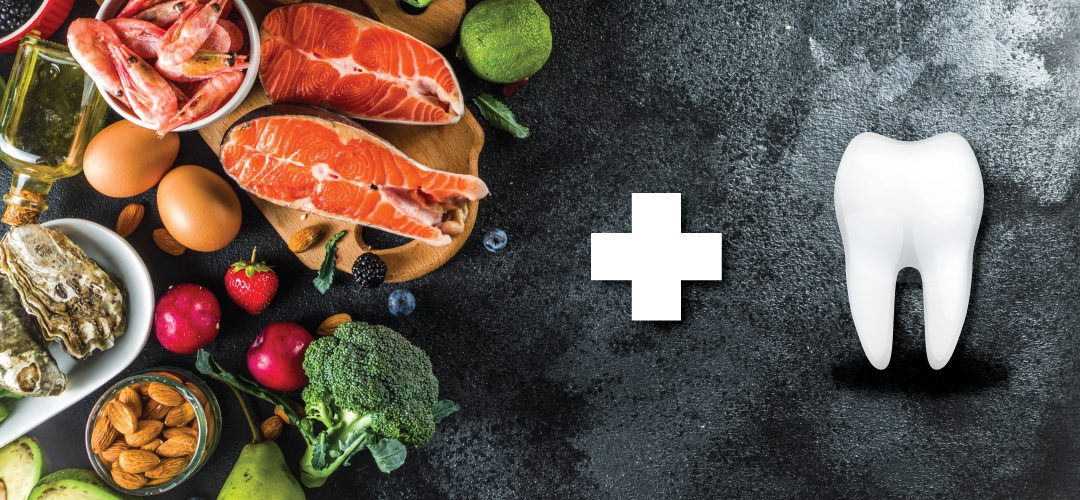Nutrition and oral health go hand-in-hand. Nutrition and oral health have a bidirectional relationship. Bidirectional means that something functions in two directions, meaning diet and nutrition affect the health of the tissues in the mouth and the health of the mouth affects the nutrients consumed. It’s very difficult to have great overall health, but poor oral health and vice versa.
A healthy lifestyle and healthy mouth are a result of many micro-decisions we make every single day, and habits are hard to change. But being aware of those decisions and how they contribute to a bigger outcome is important. We know it is hard! We suggest that you start with your diet. Diet is key to succeeding in both your oral health and overall health. Consuming too many sugar-filled sodas, sweetened fruit drinks, non-nutritious snacks such as candy and cookies, or any type of food with sugar can put you at risk for tooth decay. In addition, according to the American Dental Association (ADA) if your diet lacks certain nutrients, it may be more difficult for tissues in your mouth to resist infection. This may contribute to gum disease. Severe gum disease is a major cause of tooth loss in adults. Many researchers believe that the disease progresses faster and is potentially more severe in people with poor nutrition.
Having a well-balanced diet will help in preventing tooth decay and gum disease, but diets can be a challenge. The U.S. Department of Agriculture (USDA) has made it simpler for all of us. USDA has a new form of the original “Food Pyramid” we all grew up with, it’s called MyPlate. MyPlate focuses on starting simple and visually separates a single plate into the 5 essential food groups – fruits, vegetables, grains, protein foods and dairy – based on the daily recommended portion size. It is important to note that portion sizes depend on your age, sex, and level of physical activity. The benefits of healthy eating add up over time, bite by bite. It’s important to remember that small changes matter and the first step to a healthier nutritional and oral health lifestyle is through your diet.
Fruits
Focus on whole fruits. Any fruit or 100% fruit juice counts as part of the Fruit Group. Fruits may be fresh, canned, frozen, or dried, and may be whole, cut-up, or pureed. The amount of fruit you need to eat depends on age, sex, and level of physical activity. The amount each person needs can vary between 1 and 2 cups each day.
Vegetables
Vary your veggies. Any vegetable or 100% vegetable juice counts as a member of the Vegetable Group. Vegetables may be raw or cooked; fresh, frozen, canned, or dried/dehydrated; and may be whole, cut-up, or mashed. Based on their nutrient content, vegetables are organized into 5 subgroups: dark green; red and orange; beans, peas, and lentils; starchy; and other vegetables. The amount each person needs can vary between 1 and 3 cups each day.
Grains
Make half your grains whole grains. Any food made from wheat, rice, oats, cornmeal, barley, or another cereal grain is a grain product. Bread, pasta, breakfast cereals, grits, and tortillas are examples of grain products. Foods such as popcorn, rice, and oatmeal are also included in the Grains Group. Grains are divided into 2 subgroups: Whole Grains and Refined Grains. Whole grains contain the entire grain kernel ― the bran, germ, and endosperm. Examples of whole grains include whole-wheat flour, bulgur (cracked wheat), oatmeal, whole cornmeal, and brown rice. Refined grains have been milled, a process that removes the bran and germ. This is done to give grains a finer texture and improve their shelf life, but it also removes dietary fiber, iron, and many B vitamins. Some examples of refined grain products are white flour, de-germed cornmeal, white bread, and white rice. Most refined grains are enriched. This means certain B vitamins (thiamin, riboflavin, niacin, folic acid) and iron are added back after processing. Fiber is not added back to enriched grains. Check the ingredient list on refined grain products to make sure that the word “enriched” is included in the grain name. Some food products are made from mixtures of whole grains and refined grains. The amount each person needs can vary between 3 and 8 ounce-equivalents each day.
Protein Foods
Vary your protein routine. All foods made from seafood; meat, poultry, and eggs; beans, peas, and lentils; and nuts, seeds, and soy products are considered part of the Protein Foods Group. Beans, peas, and lentils are also part of the Vegetable Group. Select a variety of protein foods to improve nutrient intake and health benefits, including at least 8 ounces of cooked seafood per week. Young children need less, depending on their age and calorie needs. The advice to consume seafood does not apply to vegetarians. Vegetarian options in the Protein Foods Group include beans, peas, and lentils, processed soy products, and nuts and seeds. Meat and poultry choices should be lean or low-fat. The amount each person needs can vary between 2 and 6½ ounce-equivalents each day.
Dairy
Move to low-fat or fat-free dairy milk or yogurt (or lactose-free dairy or fortified soy versions). The Dairy Group includes milk, yogurt, cheese, lactose-free milk and fortified soy milk and yogurt. It does not include foods made from milk that have little calcium and a high fat content, such as cream cheese, sour cream, cream, and butter. About 90% of Americans do not get enough dairy, therefore most individuals would benefit by increasing intake of fat-free or low-fat dairy, whether from milk (including lactose-free milk), yogurt, and cheese, or from fortified soy milk or yogurt. The amount of dairy foods you need each day depends on your age and can vary between 1 ½ to 2 cups for toddlers, 2 ½ cups for children under 10 and 3 cups for older children through adults.
For more detailed dietary recommendations for children and adults based on their levels of physical activity visit ChooseMyPlate.gov. The USDA has a number of resources including videos, downloadable print materials, and a tool kit that includes a personalized plan calculator, an app and quizzes that can help you improve your nutrition and oral health by starting small and simple. Remember change happens one day at a time, one bite at a time.
Don’t forget that brushing twice a day for two minutes, flossing daily and visiting your dentist regularly (at least every 6 months) also contributes to good oral and overall health. If you haven’t been to the dentist in a while, make sure to schedule an appointment with Roseman Dental today. We can help get your oral health back on track at the same time you’re working on your nutritional health.




